#pitchclasssetimprovisation
Explore tagged Tumblr posts
Text
Harmonic and Melodic Equivalence V4

Harmonic and Melodic Equivalence V4
Get book for one dollar with promo code: buckbook
Harmonic and Melodic Equivalence V4
Add digital copy to cart - $19.99 Status: In stock, Digital book is available for immediate access.
Melodic Rotations Learning to Improvise More Based on the Composition
"Harmonic and Melodic Equivalence" is a series of books that will help you to develop many different musical skills simultaneously. The source materials for these books are exercises that contain two 3 note groupings, also called "trichords," that are manipulated in various ways. These exercises use many different types of harmonic and melodic ideas that can be superimposed over common chord progressions, scales and other musical situations. The exercises found in these courses are also great for singing and rhythm studies. Finally, the "Harmonic and Melodic Equivalence" course concentrates on the use of the three note pitch class sets (trichords) by pairing each trichord with another trichord with the same prime form. For instance, in this volume C, Db, E and F#, G, Bb are both 014 pitch class sets because they both contain a 1/2 step and a Major 3rd within their interval structure. This is a great sequence because it uses six notes that are find in any of the major modes therefore you will find a ton of useful applications which are discussed in the course.
Harmonic and Melodic Equivalence Exercises
This course is divided up into two sets of exercises written in treble and bass clef. The 1st set of exercises gets gradually harder but also more musical. Depending upon your musical skills you can start anywhere you want but for beginners I would recommend starting from the 1st exercise of the five. The 2nd set of exercises are called "Atomic Scales." These exercises are a technical exercise that really helps you to learn these ideas but also sound great as a melody right off the bat. There are 6 different types of "Atomic Scales" exercises in this course. You don't have to play every exercise in every key. But doing this will greatly increase the likelihood of you using it in real music in the future. Below is a listing of the exercises found in this course: Closed position studies. 1st inversion studies. 2nd inversion studies. Random combinations of closed position along with 1st and 2nd inversion. Random combinations of closed position along with 1st and 2nd inversion with rhythmic displacement. Atomic Scales Exercise 1 Atomic Scales Exercise 2 Atomic Scales Exercise 3 Atomic Scales Exercise 4 Atomic Scales Exercise 5 Atomic Scales Exercise 6
Explanation of 2nd Set of Exercises in Harmonic and Melodic Equivalence V4 Course
Below is an explanation for each set of the 6 different atomic scale exercises found in this course. Three octave sequences that move back and forth between the two 3 note groups are presented in six different configurations. These exercises are highly melodic and can be used verbatim as melodies when soloing. If we thought of the three notes as A,B,C then there would be six different ways to combine these notes. i.e. ABC, ACB, BAC, BCA, CAB and CBA. All exercises include MP3s as well as midi files so that you can hear and play these exercises at any tempo as well as versions in all 12 keys. Three octave sequences that move back and forth between the two 3 note groups in the ABC sequence Three octave sequences that move back and forth between the two 3 note groups in the ACB sequence Three octave sequences that move back and forth between the two 3 note groups in the BAC sequence Three octave sequences that move back and forth between the two 3 note groups in the BCA sequence Three octave sequences that move back and forth between the two 3 note groups in the CAB sequence Three octave sequences that move back and forth between the two 3 note groups in the CBA sequence
1st Set of Exercises in Harmonic and Melodic Equivalence V4 Course
Here are a few examples from the 1st set of exercises. A complete list of the different types of exercises can also be found below. Closed Position Exercise
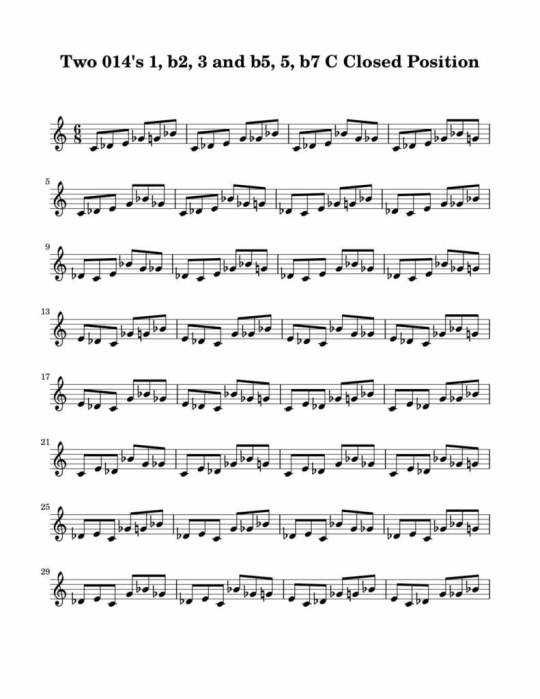
MP3 example https://s3.amazonaws.com/media.muse-eek.com/mp3/HandMEV4/01_014_Degree_1_b2_3_b5_5_b7_Closed_Position_Key_C.mp3 1st Inversion Exercise
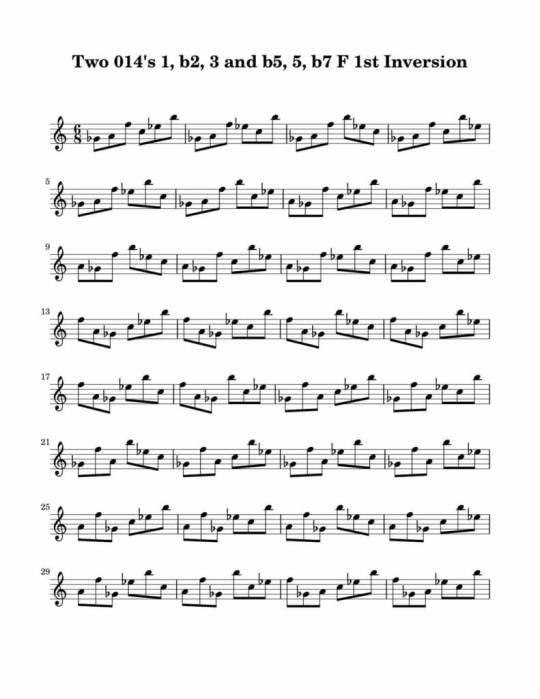
MP3 example https://s3.amazonaws.com/media.muse-eek.com/mp3/HandMEV4/02_014_Degree_1_b2_3_b5_5_b7_1st_Inversion_Key_F.mp3 2nd Inversion Exercise

MP3 example https://s3.amazonaws.com/media.muse-eek.com/mp3/HandMEV4/03_014_Degree_1_b2_3_b5_5_b7_2nd_Inversion_Key_Bb.mp3 Random combinations of closed position along with 1st and 2nd inversion.

MP3 example https://s3.amazonaws.com/media.muse-eek.com/mp3/HandMEV4/04_014_Degree_1_b2_3_b5_5_b7_Random_Inversions_Key_Eb.mp3 Random combinations of closed position along with 1st and 2nd inversion and rhythm permutation
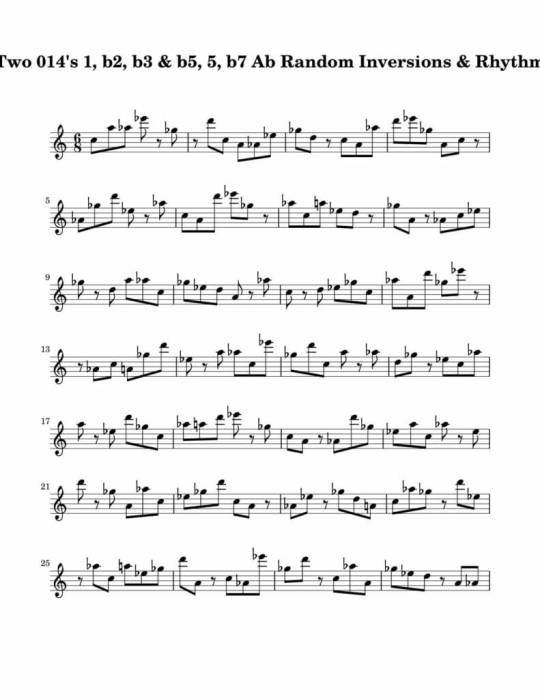
MP3 example https://s3.amazonaws.com/media.muse-eek.com/mp3/HandMEV4/05_014_Degree_1_b2_b3_b5_5_b7_Random_Inv_Rhy_Key_Ab.mp3
2nd Set of Exercises in Harmonic and Melodic Equivalence V4 Course
Here are a few examples from the 2nd set of exercises. Atomic Scales 1st Rotation
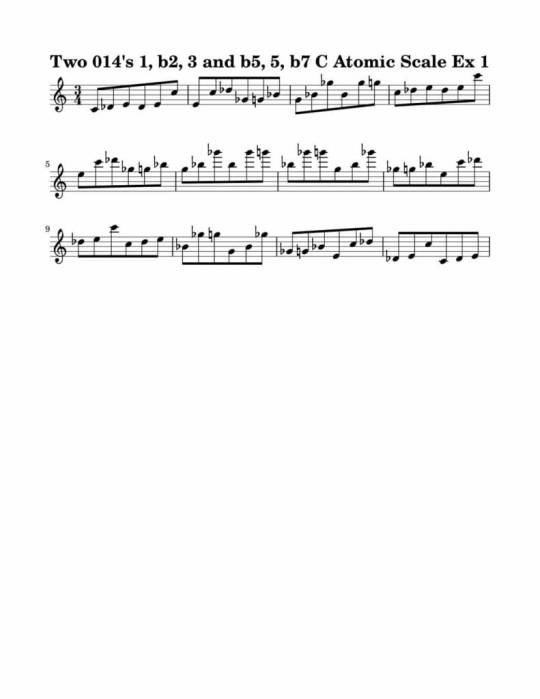
MP3 example https://s3.amazonaws.com/media.muse-eek.com/mp3/HandMEV4/01_014_Degree_1_b2_3_b5_5_b7_Atomic_Scale_Ex_1_Key_C.mp3 Atomic Scales 2nd Rotation
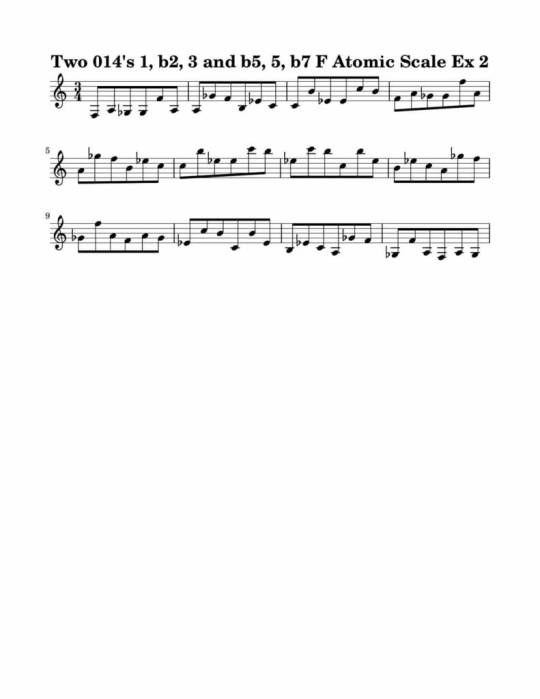
MP3 example https://s3.amazonaws.com/media.muse-eek.com/mp3/HandMEV4/02_014_Degree_1_b2_3_b5_5_b7_Atomic_Scale_Ex_2_Key_F.mp3 Atomic Scales 3rd Rotation
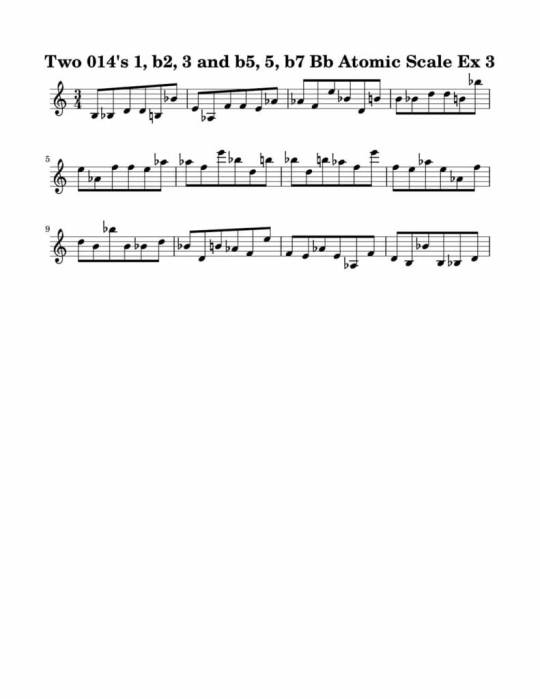
MP3 example https://s3.amazonaws.com/media.muse-eek.com/mp3/HandMEV4/03_014_Degree_1_b2_3_b5_5_b7_Atomic_Scale_Ex_3_Key_Bb.mp3 Atomic Scales 4th Rotation
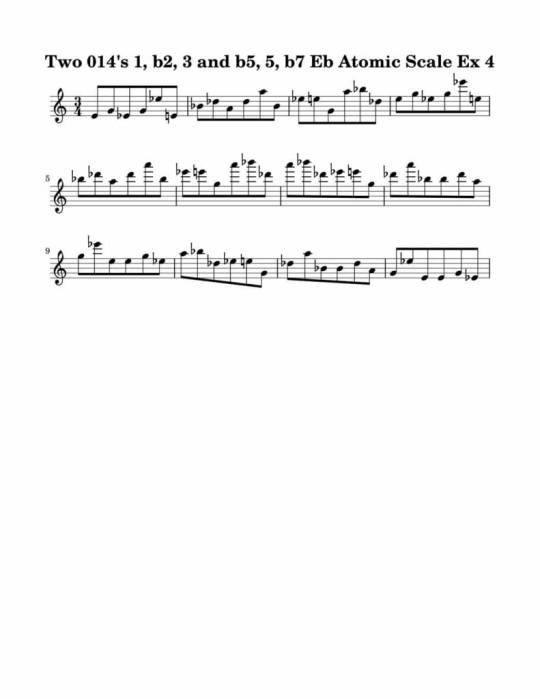
MP3 example https://s3.amazonaws.com/media.muse-eek.com/mp3/HandMEV4/04_014_Degree_1_b2_3_b5_5_b7_Atomic_Scale_Ex_4_Key_Eb.mp3 Atomic Scales 5th Rotation

MP3 example https://s3.amazonaws.com/media.muse-eek.com/mp3/HandMEV4/05_014_Degree_1_b2_3_b5_5_b7_Atomic_Scale_Ex_5_Key_Ab.mp3 Atomic Scales 6th Rotation
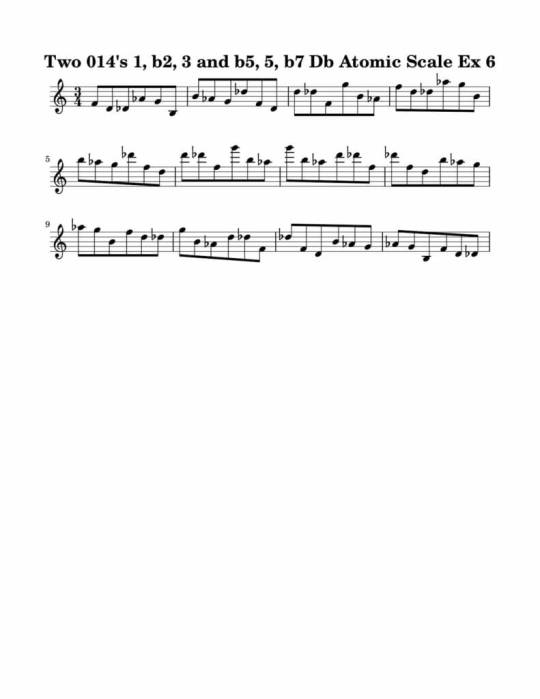
MP3 example https://s3.amazonaws.com/media.muse-eek.com/mp3/HandMEV4/06_014_Degree_1_b2_3_b5_5_b7_Atomic_Scale_Ex_6_Key_Db.mp3
TOC in the Harmonic and Melodic Equivalence V4 Course:
How to Use This Course Harmonic/Melodic Possibilities of Two 014s Chord Possibilities of Two 014s Rotations Starting on Every Eighth Note Two 014s in Modal Playing How to Think of the 014s Used in This Course 014 Daily Exercise-Atomic Scales Thinking of the Trichords as Modes Thinking of the Trichords as One Scale C, Db, E and F#, G, Bb as One Scale in All Keys Additional Practice Ideas
Get Harmonic and Melodic Equivalence V4 Today!
Add digital copy to cart - $19.99 Status: In stock, Digital book is available for immediate access. Additional Information for Harmonic and Melodic Equivalence V4: Digital Edition 978-1-59489-337-7 One 11 page PDF explaining exercises, 5 different types of exercises, 328 pages of exercises in PDF format in treble and bass clef MP3's and Midi files for all exercises. 12 MP3s from Tuba MetroDrone®
What people are saying:
Hey Muse Eek the Harmonic and Melodic Equivalence V2 and this volume has some really cool ideas for altering a 1/2-whole octatonic scale. I'm really enjoying these new sounds Thanks! J. Ogland Just wanted to drop you a note to say how much I appreciate this new series of books. The atomic scales is such an interesting way to make a melody. They all sound so refreshing. A. Andrews Bruce I just wanted to thank you for the new series Harmonic and Melodic Equivalence. I think I'm like you when you mentioned that these two triad ideas can really get under your skin. I'm really loving this concept! J. Reynolds Just wanted to say that these 014s are my favorite. I'm a big Monk fan and this sound really hits the mark!! P. Manny Read the full article
0 notes
Text
Harmonic and Melodic Equivalence V3
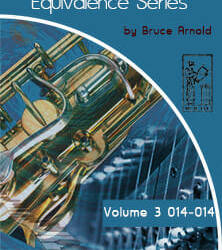
Harmonic and Melodic Equivalence V3
Use promo code: buckbook and get the course for $1.00 USD Limited Time Offer
Harmonic and Melodic Equivalence V3
Add digital copy to cart - $19.99 Status: In stock, Digital book is available for immediate access.
Melodic Rotations Learning to Improvise More Based on the Composition
"Harmonic and Melodic Equivalence" is a series of books that will help you to develop many different musical skills simultaneously. The source materials for these books are exercises that contain two 3 note groupings, also called "trichords," that are manipulated in various ways. These exercises use many different types of harmonic and melodic ideas that can be superimposed over common chord progressions, scales and other musical situations. The exercises found in these courses are also great for singing and rhythm studies. Finally, the "Harmonic and Melodic Equivalence" course concentrates on the use of the three note pitch class sets (trichords) by pairing each trichord with another trichord with the same prime form. For instance, in this volume a Blues scale is divided up into two 3 note segments. Various exercises are presented that help you master this idea and examples can be seen below. This is an excellent way to get some new ideas from an old yet great scale.
Harmonic and Melodic Equivalence Exercises
This course is divided up into two sets of exercises written in treble and bass clef. The 1st set of exercises gets gradually harder but also more musical. Depending upon your musical skills you can start anywhere you want but for beginners I would recommend starting from the 1st exercise of the five. The 2nd set of exercises are called "Atomic Scales." These exercises are a technical exercise that really helps you to learn these ideas but also sound great as a melody right off the bat. There are 6 different types of "Atomic Scales" exercises in this course. You don't have to play every exercise in every key. But doing this will greatly increase the likelihood of you using it in real music in the future. Below is a listing of the exercises found in this course: Closed position studies. 1st inversion studies. 2nd inversion studies. Random combinations of closed position along with 1st and 2nd inversion. Random combinations of closed position along with 1st and 2nd inversion with rhythmic displacement. Atomic Scales Exercise 1 Atomic Scales Exercise 2 Atomic Scales Exercise 3 Atomic Scales Exercise 4 Atomic Scales Exercise 5 Atomic Scales Exercise 6
Explanation of 2nd Set of Exercises in Harmonic and Melodic Equivalence V3 Course
Below is an explanation for each set of the 6 different atomic scale exercises found in this course. Three octave sequences that move back and forth between the two 3 note groups are presented in six different configurations. These exercises are highly melodic and can be used verbatim as melodies when soloing. If we thought of the three notes as A,B,C then there would be six different ways to combine these notes. i.e. ABC, ACB, BAC, BCA, CAB and CBA. All exercises include MP3s as well as midi files so that you can hear and play these exercises at any tempo as well as versions in all 12 keys. Three octave sequences that move back and forth between the two 3 note groups in the ABC sequence Three octave sequences that move back and forth between the two 3 note groups in the ACB sequence Three octave sequences that move back and forth between the two 3 note groups in the BAC sequence Three octave sequences that move back and forth between the two 3 note groups in the BCA sequence Three octave sequences that move back and forth between the two 3 note groups in the CAB sequence Three octave sequences that move back and forth between the two 3 note groups in the CBA sequence
1st Set of Exercises in Harmonic and Melodic Equivalence V3 Course
Here are a few examples from the 1st set of exercises. A complete list of the different types of exercises can also be found below; Closed Position Exercise

MP3 example https://s3.amazonaws.com/media.muse-eek.com/mp3/HandMEV3/01_014_Degree_1_b2_3_2_b3_7_Closed_Position_Key_C.mp3 1st Inversion Exercise
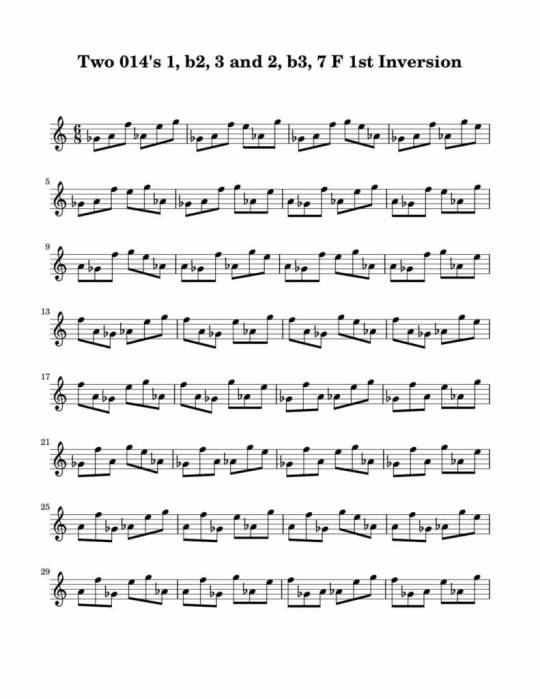
MP3 example https://s3.amazonaws.com/media.muse-eek.com/mp3/HandMEV3/02_014_Degree_1_b2_3_2_b3_7_1st_Inversion_Key_F.mp3 2nd Inversion Exercise

MP3 example https://s3.amazonaws.com/media.muse-eek.com/mp3/HandMEV3/03_014_Degree_1_b2_3_2_b3_7_2nd_Inversion_Key_Bb.mp3 Random combinations of closed position along with 1st and 2nd inversion.
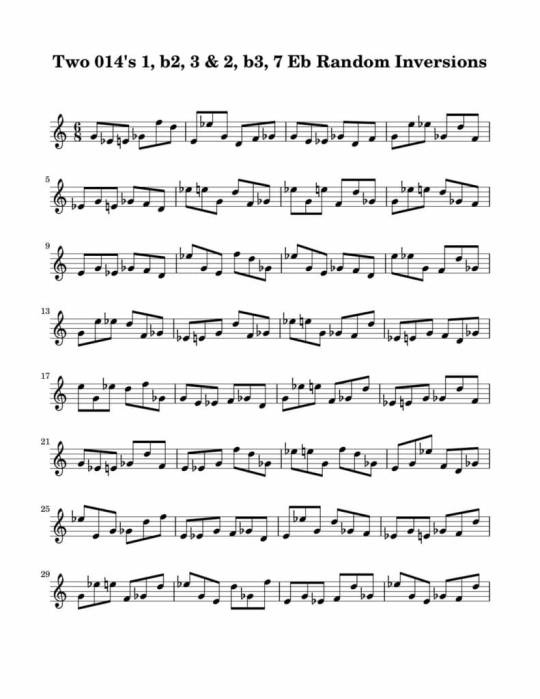
MP3 example https://s3.amazonaws.com/media.muse-eek.com/mp3/HandMEV3/04_014_Degree_1_b2_3_2_b3_7_Random_Inversions_Key_Eb.mp3 Random combinations of closed position along with 1st and 2nd inversion and rhythm permutation

MP3 example https://s3.amazonaws.com/media.muse-eek.com/mp3/HandMEV3/05_014_Degree_1_b2_3_2_b3_7_Random_Inv_Rhy_Key_Ab.mp3
2nd Set of Exercises in Harmonic and Melodic Equivalence V3 Course
Here are a few examples from the 2nd set of exercises. Atomic Scales 1st Rotation

MP3 example https://s3.amazonaws.com/media.muse-eek.com/mp3/HandMEV3/01_014_Degree_1_b2_3_2_b3_7_Atomic_Scale_Ex_1_Key_C.mp3 Atomic Scales 2nd Rotation

MP3 example https://s3.amazonaws.com/media.muse-eek.com/mp3/HandMEV3/02_014_Degree_1_b2_3_2_b3_7_Atomic_Scale_Ex_2_Key_F.mp3 Atomic Scales 3rd Rotation

MP3 example https://s3.amazonaws.com/media.muse-eek.com/mp3/HandMEV3/03_014_Degree_1_b2_3_2_b3_7_Atomic_Scale_Ex_3_Key_Bb.mp3 Atomic Scales 4th Rotation

MP3 example https://s3.amazonaws.com/media.muse-eek.com/mp3/HandMEV3/04_014_Degree_1_b2_3_2_b3_7_Atomic_Scale_Ex_4_Key_Eb.mp3 Atomic Scales 5th Rotation

MP3 example https://s3.amazonaws.com/media.muse-eek.com/mp3/HandMEV3/05_014_Degree_1_b2_3_2_b3_7_Atomic_Scale_Ex_5_Key_Ab.mp3 Atomic Scales 6th Rotation

MP3 example https://s3.amazonaws.com/media.muse-eek.com/mp3/HandMEV3/06_014_Degree_1_b2_3_2_b3_7_Atomic_Scale_Ex_6_Key_Db.mp3
TOC in the Harmonic and Melodic Equivalence V3 Course:
How to Use This Course Harmonic/Melodic Possibilities of Two 014s Chord Possibilities of Two 014s Other Groupings of the 1, b2, 2, b3, 3, 7 as a Scale How to Think of the 014s Used in This Course 014 Daily Exercise-Atomic Scales Thinking of the Trichords as Modes Thinking of the Trichords as One Scale C, Db, E and B, D, Eb as One Scale in All Keys Additional Practice Ideas
Get Harmonic and Melodic Equivalence V3 Today!
Add digital copy to cart - $19.99 Status: In stock, Digital book is available for immediate access. Additional Information for Harmonic and Melodic Equivalence V3: Digital Edition 978-1-59489-337-7 One 11 page PDF explaining exercises, 5 different types of exercises, 328 pages of exercises in PDF format in treble and bass clef MP3's and Midi files for all exercises. 12 MP3s from Tuba MetroDrone®
What people are saying:
From working with this book I have to say I'm fond of the 014 pitch class set. It reminds me of Thelonious Monk's music, which I love, but don't completely understand. This course has taken me one step closer to that understanding in that, it shows how to superimpose an 014 grouping to replace a dominant chord among other things. J. Ogland 014 is a very striking sound which took me a minute to comprehend. I've been looking for a way to change up my V7 to I7 chord voicings and melodies. While this book doesn't supply actual chord voicings it does give me tons of melodic lines. It also has a lot of charts that show how everything works in every key. J. Mannes I own all these volumes and find each one to have it's own sound and application. I love exploring these new sounds which I've mostly been using as melodies but they could work as chords too. Really appreciate you guys putting out these books they are a gold mine of practical information on how to apply these modern concepts! W. Daniels Hey Bruce, thanks for putting out this 014 book. I've been intrigued by the sound ever since I heard your composition "Numbers." To me these 014s are an eerie snake like sound that I'm really digging. U. Lucas Read the full article
#12toneimprovisation#12tonejazz#12toneexercises#pitchclasssets#trichords#pitchclasssetimprovisation#HarmonicandMelodicV3
0 notes